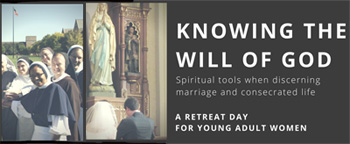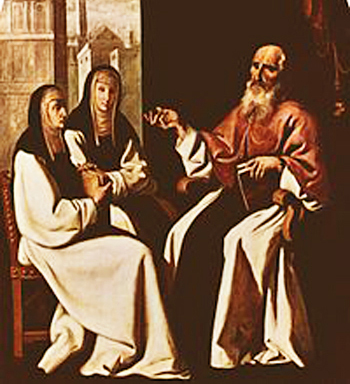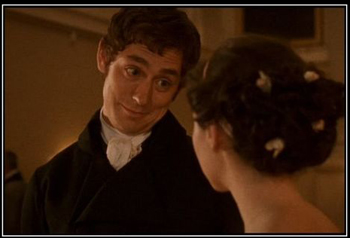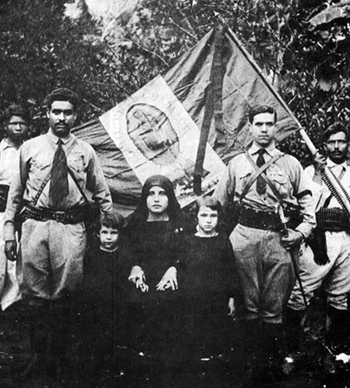Catholic Virtues
 |
 |
 |
 |
 |
 |
 |
The Single Vocation - I
The Answer for a Broken World
Having recently decided to offer my life as a lay celibate woman for the Counter-Revolution, I could not help but notice how little the single vocation is spoken about, if at all, in traditionalist circles.
 As a young convert to traditional Catholicism, I find that the only vocations that are ever presented to us are the married life, the religious life or the priesthood. For those of us who could not “fit in” to any of these three vocations, there is an unspoken but very palpable feeling of failure, especially for women.
As a young convert to traditional Catholicism, I find that the only vocations that are ever presented to us are the married life, the religious life or the priesthood. For those of us who could not “fit in” to any of these three vocations, there is an unspoken but very palpable feeling of failure, especially for women.
This erroneous idea about the vocation to be single can, therefore, be a source of great frustration, especially for those who are called to this life but are constantly dissuaded from it by those who follow the fashions and are ill-informed.
I hope to dispel this confusion and error by examining the vocation for lay celibacy more closely and, thus, show why it is the vocation that is perfectly suited to destroy the Revolution.
Vocations are ‘under construction’
The definition of vocations comes organically, from the ground up. When a certain vocational reality is presented to the Church, she defines it: In other words, the Church defines what comes as it comes.
She saw the Benedictines rise from the initial hermitage of St. Benedict of Nursia, the Dominicans from the zeal of St. Dominic in preaching against the heresies, the Jesuits from the desire of St. Ignatius to build an army for Jesus to conquer the world. Each one of the religious congregations that were born later had a similar history. The Church waits to see what is coming before trying to fit everyone into an already existing category.
She does not force a reality, she merely defines it. Vocations are based on the call of grace, which is made to assist the needs of the Church and, consequently, vocations are in constant development.
I must say that as I am writing this, I had a strong reaction against this process when I learned about it. Why? It is because we Americans have a tendency to fit in to already known categories. This tendency may have something to do with the “computer culture” in which we were raised. Vocations are not like this.
The four vocations we know now (married, priest, religious, single) were defined by organic processes.
Vocations through the ages
The vocation to the priesthood has been around since the birth of the Church, but organized religious life as we know it did not come to its full fruition in the West until the monastic movement in the early Middle Ages. Up until that point, men and women decided to live a chaste life in prayer and sacrifice, many as consecrated virgins. Some lived in the world, and some chose to live as hermits, who were the precedents and founders of future religious orders. These men and women chose to live a life of chastity and virginity, dedicated to prayer and service for the needs of the Church.
 In their time, there was no clear definition of their vocations – those celibate men and women simply wanted to not assume the life of marriage. They wanted to follow more closely in the footsteps of Our Lord as unmarried people.
In their time, there was no clear definition of their vocations – those celibate men and women simply wanted to not assume the life of marriage. They wanted to follow more closely in the footsteps of Our Lord as unmarried people.
After the expansion of monasteries and convents throughout Europe in the Middle Ages, the religious vocation often became the model for celibate life, since one could more easily live a chaste life as a religious rather than in the world.
It is wrong to think, however, that because of the prominence of religious life as a celibate vocation in the Church, the lay celibate life by itself was never a true vocation. There have been lay celibates since time immemorial. Our Lady and St. Joseph themselves were lay celibates before they married, and they kept the virginity of their previous life even after they were wed. There were many lay celibates in the beginning, including St. Catherine of Siena, St. Rose of Lima and countless other saints.
Vatican II spoiled the single vocation
Another reason the single vocation has been treated as the “ugly duckling” in traditionalist circles is Vatican II. The Council over-promoted the role of the laity, putting it on par with and even higher than the clergy. For this reason, it is understandable that there was an explosive increase in lay celibate organizations and a huge decline in priests and religious vocations. After all, why should one be a priest or religious if it is not as great as being a layperson?
Traditionalists saw this and were rightly upset. However, they over-reacted in the opposite direction: They over-stressed the vocation to the priesthood for men and religious life for women. Their mistake was to disregard the single life as a vocation. Their reasoning seems to be: “Since Vatican II over-promoted the laity, the lay celibate vocation is not really a valid vocation. So, let us promote only the married life, priesthood and the religious life.”
This mistake is incorporated into a Protestant mentality that we are so accustomed to as Americans.
Protestantism & the unfulfilled woman
The idea that every person should marry is intrinsically Protestant. For women, it comes from the old English idea that the unmarried woman is an unfulfilled woman (e.g. Jane Austen). It is the idea that “God has someone for everyone, and if you don’t have someone, then that means God is your ‘someone,’ so you have to be a priest or religious.”
 For women, this fixation is promoted with the idea of “Mr. Right”: “God has someone prepared for you, just wait until you meet Mr. Right.” This disregards an important reality: Some young men and women are not concerned about pursuing particular lives for themselves, but their attention is turned toward the cause of the Church and her needs. So, for them, there is no Mr. Right or Mrs. Right. They look forward to serving something nobler and broader – the Catholic Church in her present day needs: to free her from the progressivist infiltration she suffers and to restore her to her past glory.
For women, this fixation is promoted with the idea of “Mr. Right”: “God has someone prepared for you, just wait until you meet Mr. Right.” This disregards an important reality: Some young men and women are not concerned about pursuing particular lives for themselves, but their attention is turned toward the cause of the Church and her needs. So, for them, there is no Mr. Right or Mrs. Right. They look forward to serving something nobler and broader – the Catholic Church in her present day needs: to free her from the progressivist infiltration she suffers and to restore her to her past glory.
Not to see this is to deny that the Catholic Church should count on laypersons to help her. This is one of the results of the American Protestant influence. For this reason, traditional Catholics should purge this idea from their mentalities.
The single vocation as a weapon against the Revolution
The fact is that the Church needs lay celibates at this time. Why? It is because the Revolution infiltrated the Catholic Church through Progressivism and threatens to destroy her and our world. She needs lay celibates more than religious people and priests because most of the clergy and religious institutions are corrupted by bad doctrines and customs. Consequently, single laymen and women seem to be much less infected by the revolutionary-progressivist virus and easier to convert to an anti-progressivist mindset.
Besides, in this vocation men and women can devote all their time to destroying the Revolution and building the Reign of Mary, which must be built on purity, something that lay celibacy should have as a state of life.
Those who choose marriage cannot devote all their time to the Counter-Revolution because their time is consumed with making a living and raising sound Catholic children in the midst of a Revolutionary world, which is already a noble and colossal task in itself. Even good priests and religious cannot devote all their time to the Counter-Revolution either, because they must spend their time administering the Sacraments or they are cloistered and bound by obedience to their superiors, who may be making concessions since they are directly or indirectly linked to the progressivist Hierarchy.
Since we are in the midst of battle, the only logical choice is to fight, to focus all our time on destroying the enemy. In our day, the best vocation that is perfectly suited for this fight seems to be the lay single life.
Young people and heroism
As a millennial, I can say that young people want to heroically fight for a cause and devote their whole life to it. Furthermore, we need this heroism today. A youthful vigor and militancy is an important factor to destroy the Revolution and restore Christendom to its rightful splendor.
 I will conclude this introductory article to a series on the single vocation with these words from Dr. Plinio Corrêa de Oliveira:
I will conclude this introductory article to a series on the single vocation with these words from Dr. Plinio Corrêa de Oliveira:
“The great sense of the vocation of the generation of the present day youth today is sacrifice. Either this generation will face the hardness of its vocation with the generosity of martyrdom, or it will inevitably be demolished by the tempests that previous generations cumulated through their mistakes, and are about to fall upon the contemporary world.
“But the sacrifice required is not necessarily that of blood. It is not death that grace imposes on the youth of today as the supreme danger to face, but life itself. It is no longer the time for believers to attest to their faith by the bloody witness of martyrdom. What the Church today asks of its faithful is the witness of an exemplary life and the generous sacrifice of our whole persons to the great cause because it is necessary to fight.” (“The Indispensable Sacrifice” in The Legionario, São Paulo, n. 173, June 9, 1935)
I leave my readers to meditate on Dr. Plinio's inspiring words on the single vocation as I go to prepare my next article in this series.
Continued


A discernment retreat that ignores the single celibate life as an honorable vocation, higher than marriage
This erroneous idea about the vocation to be single can, therefore, be a source of great frustration, especially for those who are called to this life but are constantly dissuaded from it by those who follow the fashions and are ill-informed.
I hope to dispel this confusion and error by examining the vocation for lay celibacy more closely and, thus, show why it is the vocation that is perfectly suited to destroy the Revolution.
Vocations are ‘under construction’
The definition of vocations comes organically, from the ground up. When a certain vocational reality is presented to the Church, she defines it: In other words, the Church defines what comes as it comes.
She saw the Benedictines rise from the initial hermitage of St. Benedict of Nursia, the Dominicans from the zeal of St. Dominic in preaching against the heresies, the Jesuits from the desire of St. Ignatius to build an army for Jesus to conquer the world. Each one of the religious congregations that were born later had a similar history. The Church waits to see what is coming before trying to fit everyone into an already existing category.
She does not force a reality, she merely defines it. Vocations are based on the call of grace, which is made to assist the needs of the Church and, consequently, vocations are in constant development.
I must say that as I am writing this, I had a strong reaction against this process when I learned about it. Why? It is because we Americans have a tendency to fit in to already known categories. This tendency may have something to do with the “computer culture” in which we were raised. Vocations are not like this.
The four vocations we know now (married, priest, religious, single) were defined by organic processes.
Vocations through the ages
The vocation to the priesthood has been around since the birth of the Church, but organized religious life as we know it did not come to its full fruition in the West until the monastic movement in the early Middle Ages. Up until that point, men and women decided to live a chaste life in prayer and sacrifice, many as consecrated virgins. Some lived in the world, and some chose to live as hermits, who were the precedents and founders of future religious orders. These men and women chose to live a life of chastity and virginity, dedicated to prayer and service for the needs of the Church.

St. Jerome instructs St. Paula and her daughter Eustachia who chose the single celibate life
After the expansion of monasteries and convents throughout Europe in the Middle Ages, the religious vocation often became the model for celibate life, since one could more easily live a chaste life as a religious rather than in the world.
It is wrong to think, however, that because of the prominence of religious life as a celibate vocation in the Church, the lay celibate life by itself was never a true vocation. There have been lay celibates since time immemorial. Our Lady and St. Joseph themselves were lay celibates before they married, and they kept the virginity of their previous life even after they were wed. There were many lay celibates in the beginning, including St. Catherine of Siena, St. Rose of Lima and countless other saints.
Vatican II spoiled the single vocation
Another reason the single vocation has been treated as the “ugly duckling” in traditionalist circles is Vatican II. The Council over-promoted the role of the laity, putting it on par with and even higher than the clergy. For this reason, it is understandable that there was an explosive increase in lay celibate organizations and a huge decline in priests and religious vocations. After all, why should one be a priest or religious if it is not as great as being a layperson?
Traditionalists saw this and were rightly upset. However, they over-reacted in the opposite direction: They over-stressed the vocation to the priesthood for men and religious life for women. Their mistake was to disregard the single life as a vocation. Their reasoning seems to be: “Since Vatican II over-promoted the laity, the lay celibate vocation is not really a valid vocation. So, let us promote only the married life, priesthood and the religious life.”
This mistake is incorporated into a Protestant mentality that we are so accustomed to as Americans.
Protestantism & the unfulfilled woman
The idea that every person should marry is intrinsically Protestant. For women, it comes from the old English idea that the unmarried woman is an unfulfilled woman (e.g. Jane Austen). It is the idea that “God has someone for everyone, and if you don’t have someone, then that means God is your ‘someone,’ so you have to be a priest or religious.”

With Protestantism, life for women became the search of 'Mr. Right', the theme of Jane Austen novels
Not to see this is to deny that the Catholic Church should count on laypersons to help her. This is one of the results of the American Protestant influence. For this reason, traditional Catholics should purge this idea from their mentalities.
The single vocation as a weapon against the Revolution
The fact is that the Church needs lay celibates at this time. Why? It is because the Revolution infiltrated the Catholic Church through Progressivism and threatens to destroy her and our world. She needs lay celibates more than religious people and priests because most of the clergy and religious institutions are corrupted by bad doctrines and customs. Consequently, single laymen and women seem to be much less infected by the revolutionary-progressivist virus and easier to convert to an anti-progressivist mindset.
Besides, in this vocation men and women can devote all their time to destroying the Revolution and building the Reign of Mary, which must be built on purity, something that lay celibacy should have as a state of life.
Those who choose marriage cannot devote all their time to the Counter-Revolution because their time is consumed with making a living and raising sound Catholic children in the midst of a Revolutionary world, which is already a noble and colossal task in itself. Even good priests and religious cannot devote all their time to the Counter-Revolution either, because they must spend their time administering the Sacraments or they are cloistered and bound by obedience to their superiors, who may be making concessions since they are directly or indirectly linked to the progressivist Hierarchy.
Since we are in the midst of battle, the only logical choice is to fight, to focus all our time on destroying the enemy. In our day, the best vocation that is perfectly suited for this fight seems to be the lay single life.
Young people and heroism
As a millennial, I can say that young people want to heroically fight for a cause and devote their whole life to it. Furthermore, we need this heroism today. A youthful vigor and militancy is an important factor to destroy the Revolution and restore Christendom to its rightful splendor.

Young Cristeros heroically fighting for a Catholic ideal
“The great sense of the vocation of the generation of the present day youth today is sacrifice. Either this generation will face the hardness of its vocation with the generosity of martyrdom, or it will inevitably be demolished by the tempests that previous generations cumulated through their mistakes, and are about to fall upon the contemporary world.
“But the sacrifice required is not necessarily that of blood. It is not death that grace imposes on the youth of today as the supreme danger to face, but life itself. It is no longer the time for believers to attest to their faith by the bloody witness of martyrdom. What the Church today asks of its faithful is the witness of an exemplary life and the generous sacrifice of our whole persons to the great cause because it is necessary to fight.” (“The Indispensable Sacrifice” in The Legionario, São Paulo, n. 173, June 9, 1935)
I leave my readers to meditate on Dr. Plinio's inspiring words on the single vocation as I go to prepare my next article in this series.
Continued

Posted November 10, 2017














